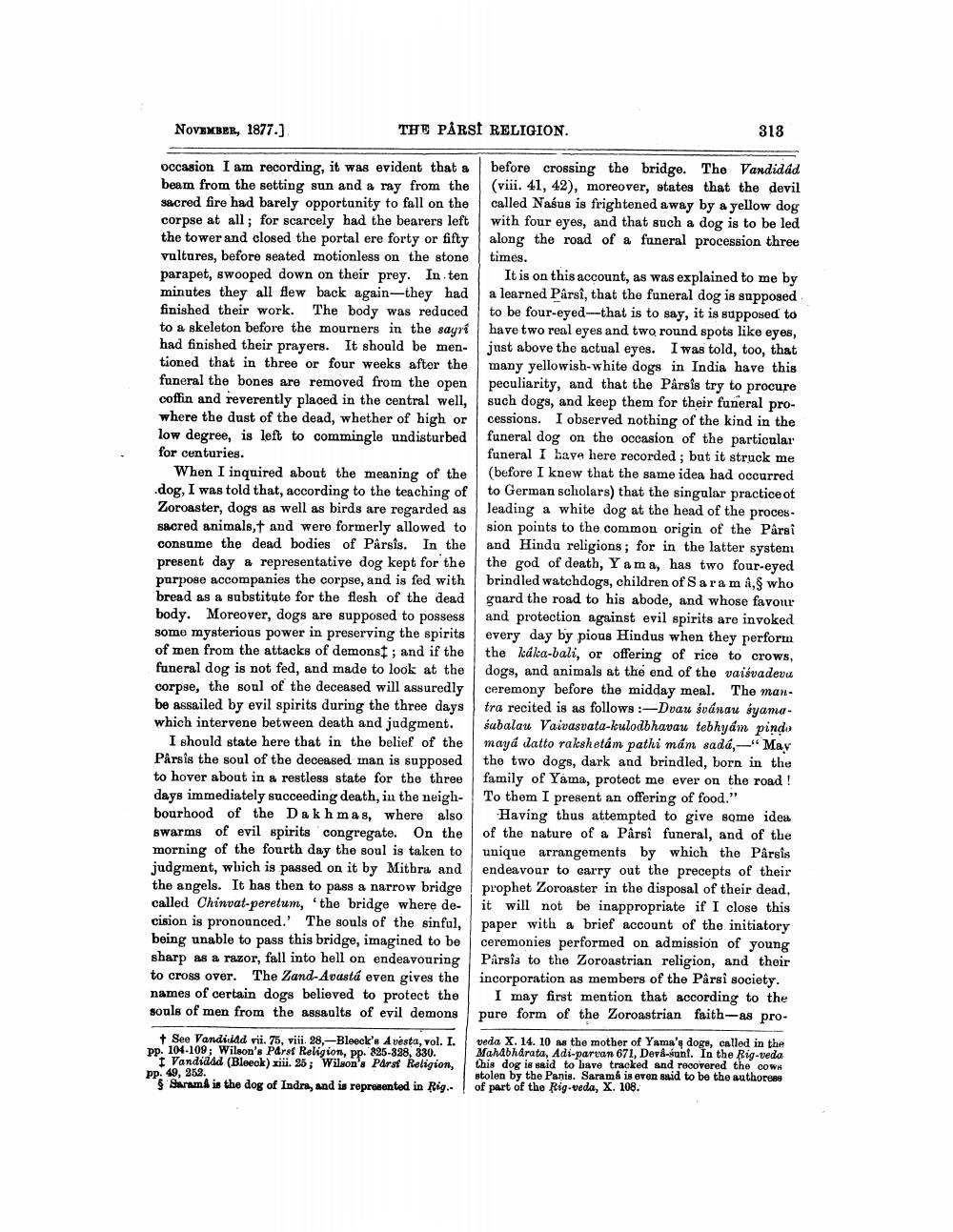________________
NOVEMBER, 1877.]
THE PÅRST RELIGION.
318
occasion I am recording, it was evident that a before crossing the bridge. The Vandidad. beam from the setting sun and a ray from the (viii. 41, 42), moreover, states that the devil sacred fire had barely opportunity to fall on the called Nasus is frightened away by a yellow dog corpse at all; for scarcely had the bearers left with four eyes, and that such a dog is to be led the tower and closed the portal ere forty or fifty along the road of a funeral procession three vultures, before seated motionless on the stone times. parapet, swooped down on their prey. In ten It is on this account, as was explained to me by minutes they all flew back again-they had a learned Pârsî, that the funeral dog is supposed finished their work. The body was reduced to be four-eyed--that is to say, it is supposed to to a skeleton before the mourners in the sayré have two real eyes and two round spots like eyes, had finished their prayers. It should be men- just above the actual eyes. I was told, too, that tioned that in three or four weeks after the many yellowish-white dogs in India have this funeral the bones are removed from the open peculiarity, and that the Parsis try to procure coffin and reverently placed in the central well, such dogs, and keep them for their funeral prowhere the dust of the dead, whether of high or cessions. I observed nothing of the kind in the low degree, is left to commingle undisturbed funeral dog on the occasion of the particular for centuries.
funeral I have here recorded; but it struck me When I inquired about the meaning of the (before I knew that the same idea had occurred .dog, I was told that, according to the teaching of to German scholars) that the singular practice ot Zoroaster, dogs as well as birds are regarded as leading a white dog at the head of the processacred animals, and were formerly allowed to sion points to the common origin of the Parsi consume the dead bodies of Parsis. In the and Hindu religions; for in the latter system present day a representative dog kept for the the god of death, Yama, has two four-eyed purpose accompanies the corpse, and is fed with brindled watchdogs, children of Saram a, who bread as a substitute for the flesh of the dead guard the road to his abode, and whose favour body. Moreover, dogs are supposed to possess and protection against evil spirits are invoked some mysterious power in preserving the spirits every day by pious Hindus when they perform of men from the attacks of demonst; and if the the káka-bali, or offering of rice to crows, funeral dog is not fed, and made to look at the dogs, and animals at the end of the vaišvadevu corpse, the soul of the deceased will assuredly ceremony before the midday meal. The manbe assailed by evil spirits during the three daystra recited is as follows :-Dvau svánau syamawhich intervene between death and judgment. sabalau Vaivasvata-kulodbhavau tebhyán pindo
I should state here that in the belief of the mayá datto rakshetam pathi mám sadá, ---"May Parsis the soul of the deceased man is supposed the two dogs, dark and brindled, born in the to hover about in a restless state for the three family of Yama, protect me ever on the road! days immediately succeeding death, in the neigh- To them I present an offering of food." bourhood of the Dakhmas, where also | Having thus attempted to give some idea swarms of evil spirits congregate. On the of the nature of a Pârsi funeral, and of the morning of the fourth day the soul is taken to unique arrangements by which the Parsis judgment, which is passed on it by Mithra and endeavour to carry out the precepts of their the angels. It has then to pass a narrow bridge prophet Zoroaster in the disposal of their dead, called Chinvat-peretum, 'the bridge where de- it will not be inappropriate if I close this cision is pronounced.' The souls of the sinful, paper with a brief account of the initiatory being unable to pass this bridge, imagined to be ceremonies performed on admission of young sharp as a razor, fall into hell on endeavouring Parsis to the Zoroastrian religion, and their to cross over. The Zand-Avustá even gives the incorporation as members of the Pârsi society. names of certain dogs believed to protect the I may first mention that according to the souls of men from the assaults of evil demons pure form of the Zoroastrian faith-as pro
+ See Vandiudd vii. 75, viii. 28.-Bleeck's A vesta, vol. I. pp. 104-109; Wilson's Parsf Religion, pp. 825-338, 330.
I Vandidad (Bleeck) xiü. 25; Wilson's Parsf Religion, pp. 49, 252.
Sarams is the dog of Indrs, and is represented in Rig
veda X. 14. 10 as the mother of Yama', doge, called in the Mahabharata, Adi-parvan 671, Derd-sung. In the Rigveda Chis dog is said to have tracked and recovered the cow stolen by the Panis. Sarams is even said to be the authorens of part of the Rigveda, X. 106.




